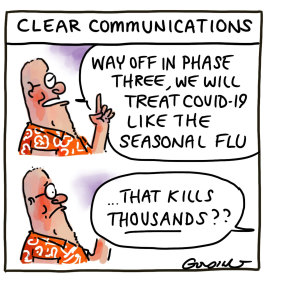This was published 3 years ago
‘A lot more dead people’: COVID too dangerous to be treated like flu
By Aisha Dow and Rachel Clun
Epidemiologists have disputed Prime Minister Scott Morrison’s claim that coronavirus will be able to be treated “like the flu” when Australia reaches a high vaccination rate, saying contact tracing and widespread mask wearing may be needed for years to avoid excess deaths.
Infectious diseases experts are optimistic that the nation will be able to reach what Mr Morrison described as the third stage of a four-stage pathway out of the pandemic, when vaccinated people can start freely travelling overseas and lockdowns are avoided.
This scenario is estimated to be feasible when 80 per cent or more of the population is fully vaccinated, although official modelling of the vaccination rates needed to move to the next phases is underway.
Epidemiologists including Nancy Baxter, head of the Melbourne School of Population and Global Health, have thrown cold water on the assertion that coronavirus could be treated like the flu. The seasonal flu has typically been managed with a vaccination program, and little else.
“We could live just our normal lives, but I just think we’d have a lot more dead people,” Professor Baxter said.
There were more than 800 flu deaths recorded in 2019, when 313,085 cases were detected, although the actual death toll is estimated to be in the thousands in an average year.
Often having the greatest impact on the elderly and sometimes killing children, the winter flu season can put significant strain on the hospital system, including intensive care units.
On Friday Mr Morrison said it was likely that by the time Australia reached phase three of the pathway, hospitalisations and deaths from COVID-19 would be similar to the flu.
“We’re already seeing evidence of that in other jurisdictions that have higher levels of vaccination,” he said.
“So, when it is like the flu, we should treat it like the flu, and that means no lockdowns.”
Chief Medical Officer Professor Paul Kelly said health experts could in the future measure success based on the number of people severely unwell with COVID-19, rather than total case numbers.
This year, Australia has recorded just over 2000 cases of COVID-19, with one death in a person who had returned from overseas. Besides Queensland, where the state keeps all positive cases in hospital, Professor Kelly said there have been few hospitalisations and very few cases in intensive care.

Illustration: Matt GoldingCredit:
“There are active cases in all but two of our jurisdictions in Australia. But throughout that, and as of today, there are only three people in intensive care out of all of those hundreds of cases now that are active in Australia,” he said.
“That’s a really crucial point. It does point to and will increasingly point to how vaccination will see us get out of this current situation,” he said.
There were more than 900 deaths from coronavirus in Australia last year, mostly in Victoria.
Burnet Institute infectious diseases expert and physician Suman Majumdar said he thought a rough vaccination target of 80 per cent would reasonably allow Australians to live with coronavirus in the community, without regular lockdowns.

Chief Medical Officer Paul Kelly believes vaccination will reduce the country’s reliance on lockdowns to manage COVID-19. Credit: Alex Ellinghausen
But he said the public should not expect it would be possible to just “let the virus go”. Instead there would likely be a gradual release of restrictions.
“Rather than the flu, I would say measles might be more similar, because measles is catastrophic if it is rampant in an unvaccinated population,” Dr Majumdar said.
University of Melbourne epidemiologist Tony Blakely said while it was “sensible” to plan for living with the virus, a high level of vaccination alone would not be sufficient to protect the public as Australia opened up.
That’s because he estimated that an extremely high vaccination rate of 90 per cent of all Australians, including children, would be required to get close to herd immunity – the point where it becomes difficult for the virus to spread through the community.
“So we will we need to keep wearing masks after some period of time ... in high-risk places like buses, trains and cramped indoor environments,” he said.
Professor Blakely also said contact tracers would need to continue tracking the virus.
“Vaccination alone is not enough for this little bugger,” he said. “It requires a package of vaccination, contact tracing, mask wearing and physical distancing.”
Professor Blakely said that living with the virus would mean there would be some deaths and illness in Australia from coronavirus “but we just have to get our way through it”.
“I think learning to live with the virus is the most sensible scenario to have. It is going to be bumpy out in the community with outbreaks here and there until we really get on top of it, and it’s going to be a little bit bumpy inside the health sector.”
Professor Baxter called for a shift in attitudes on how to prevent the spread of infectious airborne diseases, including by following the lead of many Asian countries and making regular mask-wearing the norm, as well as a bigger focus on ventilation.
A rare silver lining of coronavirus restrictions has been that cases of the flu have dropped so dramatically, it’s suspected the virus could have been eradicated from the community. Last month there were just 52 cases of influenza detected, compared with almost 60,000 in June 2019.
In the past, Professor Baxter said not enough attention had been given to how the flu could be prevented, and it was just accepted that it killed older people.
She took aim at “presenteeism” – where people go to work sick. “We now know that many of us … can work perfectly fine at home. We need to be a lot more open to that,” she said.
Stay across the most crucial developments related to the pandemic with the Coronavirus Update. Sign up for the weekly newsletter.